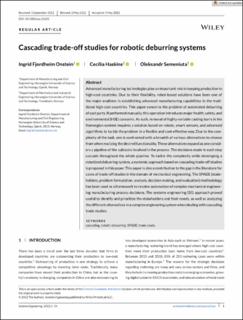| dc.contributor.author | Onstein, Ingrid Fjordheim | |
| dc.contributor.author | Haskins, Cecilia | |
| dc.contributor.author | Semeniuta, Oleksandr | |
| dc.date.accessioned | 2022-12-14T15:03:32Z | |
| dc.date.available | 2022-12-14T15:03:32Z | |
| dc.date.created | 2022-06-01T11:00:39Z | |
| dc.date.issued | 2022 | |
| dc.identifier.issn | 1098-1241 | |
| dc.identifier.uri | https://hdl.handle.net/11250/3037774 | |
| dc.description.abstract | Advanced manufacturing technologies play an important role in keeping production in high-cost countries. Due to their flexibility, robot-based solutions have been one of the major enablers in establishing advanced manufacturing capabilities in the traditional high-cost countries. This paper concerns the problem of automated deburring of cast parts. If performed manually, this operation introduces major health, safety, and environmental (HSE) concerns. As such, removal of highly variable casting burrs in the Norwegian context requires a solution based on robots, smart sensors, and advanced algorithms to tackle the problem in a flexible and cost-effective way. Due to the complexity of the task, one is confronted with a breadth of various alternatives to choose from when realizing the desired functionality. These alternatives expand as one considers a pipeline of the subtasks involved in the process. The decisions made in each step cascade throughout the whole pipeline. To tackle the complexity while developing a robotized deburring system, a systemic approach based on cascading trade-off studies is proposed in this paper. This paper is also a contribution to the gap in the literature for cases of trade-off studies in the domain of mechanical engineering. The SPADE (stakeholders, problem formulation, analysis, decision making, and evaluation) methodology has been used as a framework to resolve automation of complex mechanical engineering manufacturing process decisions. The systems engineering (SE) approach proved useful to identify and prioritize the stakeholders and their needs, as well as analyzing the different alternatives in a complex engineering system when dealing with cascading trade studies. | en_US |
| dc.language.iso | eng | en_US |
| dc.publisher | Wiley | en_US |
| dc.relation.uri | http://doi.org/10.1002/sys.21625 | |
| dc.rights | Navngivelse 4.0 Internasjonal | * |
| dc.rights.uri | http://creativecommons.org/licenses/by/4.0/deed.no | * |
| dc.title | Cascading trade-off studies for robotic deburring systems | en_US |
| dc.title.alternative | Cascading trade-off studies for robotic deburring systems | en_US |
| dc.type | Peer reviewed | en_US |
| dc.type | Journal article | en_US |
| dc.description.version | publishedVersion | en_US |
| dc.source.journal | Systems Engineering | en_US |
| dc.identifier.doi | 10.1002/sys.21625 | |
| dc.identifier.cristin | 2028678 | |
| dc.relation.project | Norges forskningsråd: 237900 | en_US |
| cristin.ispublished | true | |
| cristin.fulltext | original | |
| cristin.qualitycode | 2 | |

